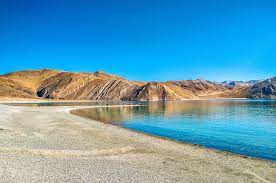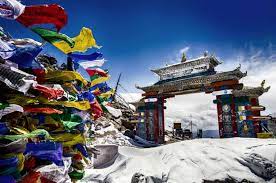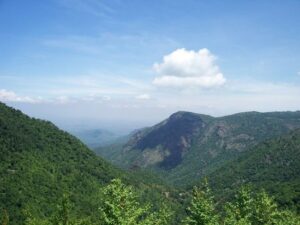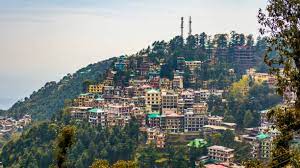Summer’s here, and it’s time to visit some cool and chilly places to relieve the sun. Here are some well-known and lesser-known tourist gems in India.
The World Is a Book, and Those Who Do Not Travel Read Only One Page
– Anonymous
LADAKH:
Ladakh, known for its beige landscape and Himalayan adventures, is a Union Territory of India and a globally recognized tourism spot. Leh, Drass Valley, Razi Khar (Chiktan Khar), Suru Valley, Kargil, Zangskar, Zangla, Rangdum, Padum, Phukthal, Sani Monastery, Stongdey, Shyok Valley, Sankoo, Salt Valley, Markha Valley, Ladakh monastery trek, South Zangskar, Trans-Zangskar Expedition, Spiti to Ladakh, Spiti to Pitok to Hemis, Rupshu, the Great Salt Lakes, and Chadar Ice Trek are some of the major tourist attractions in the district.
TAWANG:

Famous for its Buddhist monasteries, culture, and history Twanag is a hidden gem of Arunachal Pradesh and a prominent center for Gelug, or Gelugpa, the preeminent Buddhist school in Tibet. It shares its boundaries with Tibet in the north, Bhutan in the southwest, and the Sela Range of West Kameng in the east.
Due to the Tawang Monastery’s excellent preservation, Tawang is a well-liked tourist attraction. The Sela Pass rises sharply and is mostly always covered in snow. A popular tourist destination is the Jang waterfall and Chumi Gyatse Falls. A handicrafts centre in Tawang district supports local small-scale handicrafts companies.
AULI:

One of the prominent places in India for skiing, Auli is located in the western region of the Gharwali Hills. Along with being one of the top skiing locations in India, Auli provides skiers with a mesmerizing view of a variety of snow-covered peaks, including Dunagiri, Mt. Nanda Devi, Nar Parbat, Mana Parwat, Ghori Parbat, Nilkanth, Beethartoli, and Hathi Parbat. November to March is the best time to visit Auli if you want to enjoy the skiing season.
PONDICHERRY:

Officially known as Puducherry and often referred to as “Pondy,” it is one of the nine Union Territories of India. The former French colony, also referred to as “the French Capital of India’ or “the French Riviera of the East’, is the perfect mix of French architecture and Indian cultural sensibilities, providing the best of both worlds to those exploring the city.
Numerous colonial structures, including churches, temples, and monuments, together with the city’s town planning and French-style roads in its older neighbourhoods, have helped to preserve much of the colonial air. Some of the well-known tourist attractions for travellers include Promenade Beach, Sri Aurobindo Ashram, the Children’s Park and Dupleix Statue, Gandhi and Nehru statues, Le Café, the French War Memorial, the 19th Century Light House, Bharathi Park, the Governors Palace, the Romain Rolland Library, the Legislative Assembly, the Pondicherry Museum, and the French Institute of Pondicherry at Saint Louis Street.
KALIMPONG:

One of only three ecoregions in India, the region of Kalimpong is located in the Eastern Himalayas and is regarded as an ecological hotspot. Within the Kalimpong neighbourhood is Neora Valley National Park, which is home to tigers. Although ethnic Indian Gorkhas make up the majority of the population, the Lepchas were the city’s original founders. They flocked to Kalimpong from Tibet and Nepal in pursuit of employment when it was ruled by the British. Along with tourism, Kalimpong is also known for its horticulture and boasts over 4000 species of flowering plants, including over 400 types of orchids. Morgan House Durpin Dara Hill, Cactus Nursery, Deolo Hill, Mangal Dham, Teesta Bazar, Kalimpong Science Centre, Lepcha Museum, etc. are some of the major tourist attractions.
YERCAUD:

Yercadu, located in the Shevaroys Range of Hills in the Eastern Ghats, is situated in the Salem District of Tamil Nadu. The hill station is known for its flora and fauna, lakes, temples, and scenic views, with some great trekking spots nearby as well. Around 5 km from the Yercaud lake, in the Shevaroy Hills (also known as Shevarayan Hills), an old shrine with stone-age artefacts has been discovered.
MCLEODGANJ:

Also known as “Little Lhasa” or “Dhasa”, Mcleodganj is a suburb of Dharmshala in the Kangra District of Himachal Pradesh. The town is well known for its historical involvement in the Anglo-Sikh wars and used to be a holiday spot for the British in the summer. Lord Elgin, the British Viceroy of India (1862–63), liked the area so much that at one point he suggested it be made the summer capital of India. Along with its cozy cafes and monasteries, the Dalai Lama Temple, Bhagsu Waterfall, Triund Trek, St.John in the Wilderness Church, Namgyal Monastery, Tibetian Museum, and Knagra Fort are some of its major tourist spots. In addition to these tourist attractions, McLeod Ganj is also known for its vibrant culture, delicious food, and scenic surroundings. It is a popular destination for backpackers, adventure enthusiasts, and spiritual seekers.
RISHIKESH:

Set against the backdrop of the Himalayas in the northern Indian state of Uttrakhand, Rishikesh is known as the “Yoga Capital of the World” and is a hub for adventure sports and spiritual tourism. Along with its historical and mythological importance, the city is also known for its connection to the Beatles. Several other international artists, including Mike Love of the Beach Boys, Paul Horn, Donovan, and Gyp Mills, visited the site to contemplate and meditate. Rishikesh is also a town of quaint cafes, which offer local and international cuisines and has recently become very popular for its vibrant Holi celebrations. Triveni Ghat, Ram Jhula and Laxman Jhula, Neer Garh Waterfall, Parmarth Niketan, Rajaji National Park, and White Water Rafting are some of the major tourist attractions of Rishikesh.
PITHORAGARH:

Pithoragarh is a Himalayan town in Uttrakhand. It is the largest town in the Kumaon Hills and is the education hub of the hilly region. Pithoragarh city and its surrounding areas were part of the Manaskhand region, which makes them important historically as well as mythologically. It has also been part of kingdoms like the Kurmanchal and under the rule of the Bam Kings of Saur. It is known for its scenic beauty, serene atmosphere, and rich cultural heritage. The town has many ancient temples, historical sites, and natural attractions that make it a popular tourist destination. Some of the popular tourist attractions in Pithoragarh are Pithoragarh Fort, Kapileshwar Mahadev Temple, Askot Wildlife Sanctuary, Kafni Glacier, Dharchula, Patal Bhuvaneshwar Cave, Ralam Glacier, and Berinag.
ALMORA:

The cultural capital of Kumaon and a cantonment town in Uttrakhand, Almora is located on a ridge at the southern edge of the Kumaon Hills of the Himalaya range. The Koshi (Kaushiki) and Suyal (Salmale) rivers flow along the city, and the snow-capped Himalayas can be seen in the background. Once the capital of the Chand dynasty rulers, Almora is known for its rich cultural heritage, unique handicrafts, and delicious cuisines, as well as its colonial charisma. Kasar Devi Temple, Binsar Wildlife Sanctuary, Bright End Corner, Katarmal Sun Temple, Golu Devta Temple, Kumaon Regimental Centre Museum, Jageshwar Temple, and Zero Point are some major tourist attractions. The town also serves as the starting point for many treks, like Jageshwar, Pindari, Mornaula, Mukteshwar, Binsar, and Ranikhet, among others.


